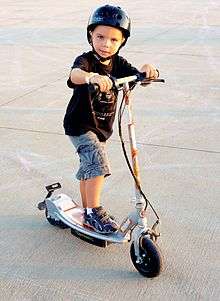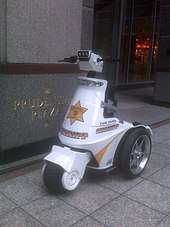Motorized scooter

A motorized scooter (also gas scooter) is a powered stand-up scooter using a small utility gas engine or electric motor.[1] These scooters are generally designed with a large "deck" in the center on which the operator may stand. The first production scooter, the "Sport" was released by Go-Ped in 1985. Recently electric kick scooters have grown in popularity. These are considered by many legislative bodies to be distinct from motorized scooters like the popular Vespa.
History
- 1915: Autoped introduces its stand-up scooter. Pulling back on the handlebar disengaged the clutch and applied the brake. Autoped continued production until 1921; Krupp of Germany built the Autoped under licence from 1919 to 1922.[2][3]
- 1986: Go-Ped introduces the first production stand-up scooter, the "Roadster", quickly followed by the "Sport"
- May 2001: Go-Ped introduces the first full suspension stand-up electric scooter, the "Hoverboard."
- 2004: Evo Powerboards introduces the first scooter with a two-speed transmission, the "2x."
- November 2009: Go-ped introduces their first completely propane powered scooter and go-kart, the "GSR Pro-Ped" and the "GSR Pro-Quad"
- 2013-2014: light electric folding scooters based on lithium batteries and brushless hub motors become available.
- 2018: dockless scooter-sharing systems roll out in major cities, largely as expansions of bike-sharing systems.[4]
Electric

Electric kick scooters have generally surpassed gas engined scooters in popularity since 2000.[5] They usually have two hard small wheels, with a foldable chassis, usually aluminum. Some kick scooters have 3 or 4 wheels, or are made of plastic, or are large, or do not fold. High performance trickster scooters made for adults resemble the 19th century penny-farthing, with a much larger wheel in front. Electric kick scooters differ from mobility scooter in that they also allow human propulsion, and have no gears. Range typically varies from 5 to 50 km (3 to 31 mi), and maximum speed is around 30 km/h (19 mph).[6][7]
In 2017, some bicycle-sharing companies such as Lime, and some scooter-only companies, like Bird, began offering dockless electric kick scooter sharing services. This segment of the micro-mobility market made large inroads in 2018, with numerous dockless electric scooters appearing in major cities worldwide,[8] sometimes in controversial and contentious unsanctioned roll-outs, such as in San Francisco.[9]
Overview
Usage

In addition to its usage for transportation, motorized stand-up scooters may be used in law enforcement, security, or patrolling.[10][11]
Wheels and tires
There are two general categories of tires on which stand-up scooters travel—hard tires and air tires. Hard tires are generally 6 inches (150 mm) in diameter and constructed of a hard-plastic insert surrounded by a solid rubber tire. Air tires are most often 10 inches (250 mm) in diameter. They are constructed of a steel or aluminum split rim, an inner tube and rubber tire. Other, less common wheel and tire types include 8 inches (200 mm) and 13 inches (330 mm) air tires.
Transmissions
The most simplistic drive mechanism of stand-up scooters is the "spindle" drive. This drive mechanism puts an extension of the engine's output shaft, the spindle, in direct contact with the rear tire of the scooter. In order to function correctly, the tire must have a clean, dry surface which the spindle will be able to effectively interact with. Scooters with this type of direct transmission can be pull started with the rear wheel off of the ground or "bump" started by forcefully pushing the scooter with the rear tire in contact with the ground.
Simple chain reduction drives are also used to transfer energy to the rear wheel from the engine. These generally incorporate a type of centrifugal clutch to allow the engine to idle independently.
Belt reduction drives use the combination of wide flat "cog" belts and pulleys to transfer power to the rear wheel. Like chain drives, belt drives include a centrifugal clutch. Belt drives are more susceptible to breakage in off-road conditions.
Suspension
The suspension systems of stand-up scooters range from simplistic spring based fork systems to the complicated, dampened cam-link and C.I.D.L.I[12] suspension mechanisms.
Legality
- United States
In many areas in the United States motorized scooters are not street legal, as they cannot be tagged, titled, insured, and do not meet federal requirements for lights or mirrors. Particular localities may have further ordinances that limit the use of motorized scooters. The top speed of the average motorized scooters is around 20 miles per hour (32 kilometres). Due to their small wheels motorized scooters are not typically safe for street use as even the smallest bumps can cause an accident.
California requires a person riding a motorized scooter on a street must be 16 years of age or older, have a valid driver's license, be wearing a bicycle helmet, have no passengers, and otherwise follow the sames rules of the road the same as cars do. The motorized scooter must have brakes, may not have handlebars raised above the operator's shoulders, and if ridden at night must have a headlight, a taillight, and side reflectors. A motorized scooter may not be operated on sidewalks or on streets if the posted speed limit is over 25 mph (40 km/h) unless in a Class II bicycle lane.[13]
Gallery



See also
References
- ↑ "Some kick scooters are fitted with a seat though".
- ↑ Wilson, Hugo (1995). "The A-Z of Motorcycles". The Encyclopedia of the Motorcycle. London: Dorling Kindersley. p. 22. ISBN 0-7513-0206-6.
- ↑ Wilson, Hugo (1995). "The Directory of Motorcycles". The Encyclopedia of the Motorcycle. London: Dorling Kindersley. p. 243. ISBN 0-7513-0206-6.
- ↑ Robinson, Melia (2018-04-02). "Electric scooters for grown-ups are taking over San Francisco, and tech workers are annoyed". Business Insider. Retrieved 2018-06-03.
- ↑ "The History of The Motorized Electric Scooter". February 2010. Retrieved February 28, 2018.
- ↑ "It's Too Bad Electric Scooters Are So Lame, Because They May Be the Future". Wired. January 2016. Retrieved December 8, 2017.
- ↑ Neil, Dan (September 22, 2015). "The URB-E: An Electric Scooter That's a Thrill to Ride". The Wall Street Journal. Retrieved April 4, 2016.
- ↑ Morris, Sarah (2018-09-06). "An Electric Kick-Scooter Sharing Service Is Coming to Melbourne". Broadsheet. Retrieved 2018-09-16.
- ↑ Raphelson, Samantha (2018-08-29). "Dockless Scooters Gain Popularity And Scorn Across The U.S." NPR.org. Retrieved 2018-09-16.
- ↑ Kaminer, Ariel (22 October 2010). "To Serve and Protect, Perched on 3 Wheels". New York Times. Retrieved 15 November 2012.
- ↑ "Pentagon Deploys T3 Series Clean Energy, Electric Stand-up Vehicle for Perimeter Security". T3 Motion, Inc. Reuters. 6 January 2011. Archived from the original on 30 January 2011. Retrieved 15 November 2012.
- ↑ Cantilevered Independent Dynamic Linkless Indispension
- ↑ "Scooter and Go-Ped Guidelines". Archived from the original on 2011-03-11. Retrieved 2010-05-18.